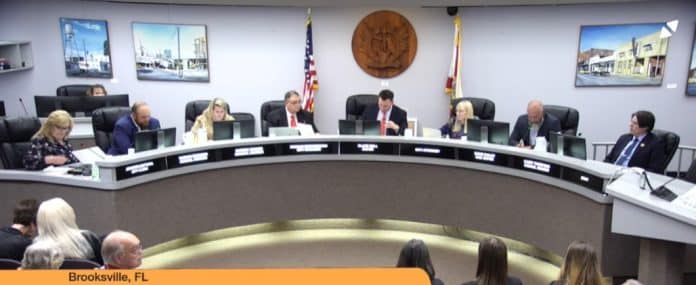New land development codes approved in first public hearing
In late March, the Brooksville City Council unanimously approved the passing of Ordinance 966, which is a temporary moratorium on accepting and processing plans for building developments within Brooksville’s city limits. The purpose of the moratorium was to allow the city to create a set of land use regulations that would guide the city’s development for the foreseeable future. When the Sun first covered this, Ordinance 966 had been adopted days earlier. Since then, there have been a series of meetings dealing with the creation of land use regulations. One of the items on the agenda at the Aug. 21 city council meeting was the first hearing of Ordinance 969, which is a proposal to amend the Land Use Regulations that have been proposed.
After discussing various items on the agenda, the council members, which included Mayor Blake Bell, Vice Mayor David Bailey, Thomas Bronson, Christa Tanner, and Casey Thieryung, approved the new ordinance. The amendment addressed a list of 10 items, referred to as “exhibits,” that called for changes in the provisions of the regulations. Below is the litany of tweaks submitted and presented by Community Development Director David Hainley and passed by the city council:
• Exhibit A: Height and Bulk Standards refers to the capped height of buildings for districts, architectural standards so that “occupiable space has one setback,” and maximum floor limits are reduced from four to three in certain zones.
• Exhibit B: Planned Development deals with processing at a staff level and essentially allows the development community to write their own “PD” text.
• Exhibit C: Commercial Design Standards were already existing and simply modified. The text regarding landscaping was appropriately moved to the landscaping section of the amendment.
• Exhibit D: Multifamily Design Standards do not allow for flat roofs and require them to be of either the gable or hip variety. Other aspects this deals with are the base, midpoint, and cap of multi-family housing, as well as materials, among other details.
• Exhibit E: Residential Design Guidelines is a set of guidelines for single-family homes that will come “through the PD process” for any new development.
• Exhibit F: Landscaping serves as a rewrite of the current landscaping regulations, which incorporate commercial standards and lot standards for single-family landscaping. One part of the code was changed from requiring “one tree in the yard to a requirement for two trees in the yard” as well as a “street tree.”
• Exhibit G: Fences and Walls results in the city becoming more compliant with Hernando’s standards on fences and walls.
• Exhibit H: Sign Regulations mandates a rewriting of the regulations due to the Gilbert, Arizona decision regarding signs. The city may regulate by “location and by function, but not by content.” It also requires signs to be updated to monument signs, as opposed to pole signs, with a grace period of 10 years for any particular business to bring theirs into compliance.
• Exhibit I: Design Review Board deals with the residential review guidelines required by state code.
• Exhibit J: Definitions simply addresses the ordinance changes.
Section 7-1.9: Electronic Message Boards was not recommended by the Planning and Zoning Commission and thus was not adopted as part of the ordinance by the city council. The result is that electronic message boards will not be allowed in the city of Brooksville, but the members are able to revisit the issue later if the council chooses.
Before the ordinance was approved, the council members also had a pair of items within the amendment that they discussed and amended further. These items included the number of stories permitted in multi-family housing developments and the grandfathering of pole signs. Mayor Bell proposed that they limit multi-family developments to two stories, with an option for a third at the council’s discretion. Council Member Tanner voiced concern for “iconic” pole signs owned by businesses such as Luigi’s and put forth the idea of a grandfather clause for these sorts of signs to preserve the charm and nostalgia of Brooksville.
“This is to make Brooksville better and to keep the history of Brooksville, right?” said Tanner. “I don’t want to throw the baby out with the bathwater here on pole signs and get rid of pole signs that have been here for generations just because, moving forward, we obviously don’t want them.”
With the issues addressed and the exhibits amended, the council members are set to reconvene for a second and final reading of Ordinance 969 on September 18 of this year.

